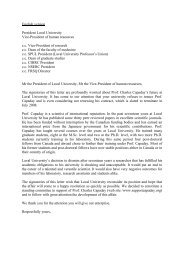Untitled - Laboratory of Neurophysics and Physiology
Untitled - Laboratory of Neurophysics and Physiology
Untitled - Laboratory of Neurophysics and Physiology
You also want an ePaper? Increase the reach of your titles
YUMPU automatically turns print PDFs into web optimized ePapers that Google loves.
2. Schmuker M, Schneider G: Processing <strong>and</strong> classification <strong>of</strong> chemical data inspired by insect olfaction.<br />
Proc Natl Acad Sci USA 2007, 104:20285-9.<br />
3. Schmuker M, Yamagata N, Nawrot MP, Menzel R Parallel representation <strong>of</strong> stimulus identity <strong>and</strong><br />
intensity in a dual pathway model inspired by the olfactory system <strong>of</strong> the honeybee. Front Neuroeng<br />
2011, 4:17.<br />
4. Haas JS, Nowotny T, Abarbanel HDI: Spike-timing-dependent plasticity <strong>of</strong> inhibitory synapses in the<br />
entorhinal cortex. J Neurophysiol 2006, 96:3305-13.<br />
5. Vogels TP, Sprekeler H, Zenke F, Clopath C, Gerstner W: Inhibitory Plasticity Balances Excitation <strong>and</strong><br />
Inhibition in Sensory Pathways <strong>and</strong> Memory Networks. Science 2011, 334:1569-73.<br />
O13<br />
Mechanisms <strong>of</strong> sharp wave-ripple generation <strong>and</strong> autonomous replay in a hippocampal<br />
network model<br />
Szabolcs Káli 1,2⋆ , Eszter Vértes 1,2,3 , Dávid G Nagy 1 , Tamás F. Freund 1,2 , <strong>and</strong> Attila Gulyás 1<br />
1 Institute <strong>of</strong> Experimental Medicine, Hungarian Academy <strong>of</strong> Sciences, Budapest, Hungary<br />
2 Pázmány Péter Catholic University, Faculty <strong>of</strong> Information Technology, Budapest, Hungary<br />
3 École Polytechnique Fédérale de Lausanne, Switzerl<strong>and</strong><br />
Several distinct patterns <strong>of</strong> population activity can be recorded in the hippocampus in vivo. These<br />
neural activity patterns depend on the behavioral state <strong>of</strong> the animal, <strong>and</strong> include theta-modulated<br />
gamma oscillations as well as low-level irregular activity with periodically occurring large-amplitude<br />
sharp wave-ripple (SWR) events. During SWRs, neuronal populations in the hippocampus have been<br />
found to “replay”, on a faster time scale, activity recorded during theta-gamma activity in the exploring<br />
animal. Such replay may be important for the establishment, maintenance <strong>and</strong> consolidation<br />
<strong>of</strong> long-term memory. Our aim was to develop a mechanistic underst<strong>and</strong>ing <strong>of</strong> cellular <strong>and</strong> network<br />
mechanisms underlying the generation <strong>of</strong> SWRs in general, <strong>and</strong> spatio-temporal sequence replay during<br />
SWRs in particular, based on in vitro <strong>and</strong> in vivo experimental observations.<br />
A recently developed hippocampal slice preparation, in which SWRs arise spontaneously, has allowed<br />
the collection <strong>of</strong> a large <strong>and</strong> diverse set <strong>of</strong> data regarding the properties <strong>of</strong> SWRs, as well as the<br />
characterization <strong>of</strong> several cell types <strong>and</strong> synapses which are critical in their generation. Based on<br />
these data, combined with phase-plane analysis <strong>of</strong> the network dynamics, we developed a large-scale<br />
network model <strong>of</strong> the hippocampal CA3 region. We found that our model based on measured cellular<br />
<strong>and</strong> synaptic parameters could faithfully reproduce the experimentally observed SWR activity as long<br />
as we included an appropriate slow feedback mechanism which was responsible for the termination <strong>of</strong><br />
SWR bursts. Our model allowed us to rule out several potential c<strong>and</strong>idates (such as neuronal adaptation)<br />
for the slow feedback process, suggesting that either slowly activating interneuronal feedback or<br />
short-term synaptic plasticity <strong>of</strong> connections within CA3 might terminate SWRs. Statistical analysis<br />
<strong>and</strong> fitting <strong>of</strong> the inter-event interval distribution <strong>of</strong> SWRs in vitro suggested that, following an initial<br />
’refractory period’ after each SWR, the next SWR is initiated stochastically, requiring the simultaneous<br />
activation <strong>of</strong> a threshold number <strong>of</strong> pyramidal cells. When we implemented the changes in cellular<br />
<strong>and</strong> synaptic properties measured in the slice following the activation <strong>of</strong> cholinergic receptors, our<br />
model replicated the experimentally observed transition from SWR activity to gamma oscillations.<br />
Finally, applying a spike-timing-dependent plasticity rule to the recurrent excitatory weights during<br />
simulated exploration, the emerging weight structure led to the spontaneous replay <strong>of</strong> sequences <strong>of</strong><br />
place cell representations during simulated SWRs. We also found that using structured rather than<br />
r<strong>and</strong>om weights substantially altered the global network dynamics, resulting in a sparse participation<br />
<strong>of</strong> pyramidal neurons in individual SWR events, <strong>and</strong> allowing our model to match more closely the<br />
68



